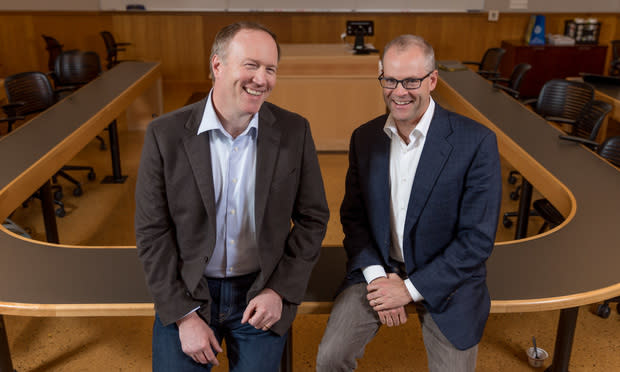Berkeley Law Offering a Realistic Taste of Patent Practice
[caption id="attachment_6071" align="alignnone" width="620"]

Jeffrey Homrig, Latham & Watkins, and Steven Carlson, Kasowitz Benson Torres. [/caption] Somewhere in a Berkeley classroom, law students are plotting to take down inventor Leigh Rothschild. With instruction from two prominent IP litigators—and cameos from a real client, expert witness and PTAB judges—students in Berkeley Law's Patent Litigation II class are drafting and arguing petitions for inter partes review (IPR). The target is U.S. Patent No. 8,424,752, a patent on QR code technology owned by Rothschild's Symbology Innovations LLC. Symbology has asserted the patent in more than 100 lawsuits filed over the last three years. Many have settled. To date no one has challenged the patent's validity via IPR. The Berkeley students will not be the first. They aren't actually going to file their petitions with the Patent Trial and Appeal Board (PTAB). But instructors Steven Carlson and Jeffrey Homrig are otherwise making the experience as realistic as possible. While Patent Litigation II is not a clinic, Carlson and Homrig want the students to learn by doing. IPRs are a consideration in virtually every patent case today, they say. "It's such a core skill set for IP litigation, it's important to have as part of the tool kit," said Carlson, who's a partner at Kasowitz Benson Torres. Of course, it's possible IPRs won't be around much longer. The U.S. Supreme Court is hearing a constitutional challenge to the procedure Nov. 27. But even if IPRs disappear, says Latham & Watkins partner Homrig, the students are learning "how to tackle a real world problem" while factoring in business considerations "that you're not always as a lawyer pre-programmed to think about."
Join Law.com IP reporter Scott Graham for day-after analysis of the Supreme Court arguments in Oil States and SAS Institute.
For details and to register, click here.
The two lawyers started off the class by enlisting Unified Patents COO Shawn Ambwani to help brainstorm potential IPR targets. Unified also donated a prior art search for the '752 patent. The students considered those results and then did additional searching. At his law firm, said Homrig, "what we do in real life is we have a meeting, and different people present on different pieces of art—what's strong, what's weak, what are the pros and cons?" So the students presented to each other, then working as teams selected the prior art they wanted to rely on. Next came the client presentation. Students pitched strategy and risks to Li Westerlund, vice president for intellectual property at biotech Bavarian Nordic. (Westerlund's company, like Carlson's and Homrig's firms, are not involved in any Symbology litigation.) Westerlund didn't make things easy. For some teams, "she came in as the knowledgeable VP of IP. For another group she came in as the general counsel who assumed she knew everything about IP but did not," Carlson said. Westerlund challenged all of the students about the business implications of their law-driven decisions. As the teams turned to drafting their IPRs, they met with cloud computing entrepreneur Roger Bodamer, playing the role of expert witness. Afterward each team drafted an expert report. Finally, two pairs of PTAB judges from the PTO's Silicon Valley branch visited the class to hear mock arguments. The students "had to come up with bullet points of what you would say if you were on the other side, and then they argued to sitting PTAB judges," Homrig said. Unified Patents, which is among the 10 most active filers of IPRs in the country, is in talks with several schools about similar projects—but structured as a clinic. That way Unified, acting as the client, could file the finished IPR petition with the PTAB, Ambwani says. Because the PTAB by statute must act within six months, students would get a decision on whether to institute proceedings by the time they take the bar exam. "We think that would be a very good badge to have on a resume," he says.

